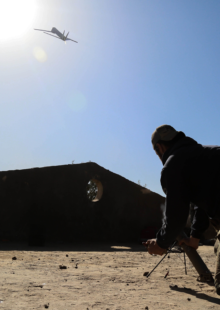A Laboratory of Drone Warfare
November 22, 2022
The role and relevance of uncrewed aerial systems in the war in Syria
Download 5.79 MB
The skies above conflict zones in the 21st century are marked by the presence of Uncrewed Aerial Vehicles (UAVs), better known as drones. The deployment of drones has become commonplace over the last two decades, both within an outside areas of armed conflict. Whether they are armed or not, drones leave their mark on the way contemporary conflicts are fought, and provide both states and non- state actors with new methods of using lethal force. UAVs give warring parties ‘eyes in the sky’, a 24/7 source of intelligence on the whereabouts of the enemy.
Hovering above conflict zones, drones collect information on the battlefield by carrying out Intelligence, Surveillance, Target Acquisition and Reconnaissance (ISTAR) with the aid of a wide array of onboard sensor systems and cameras. These functionalities support the role of drones, linking it either with other weapon systems on the ground or air and using the sensor data for targeting, or by directly engaging the targets with onboard rockets, missiles or bombs. Their application in warfare gives armies multiple advantages, like improved situational awareness and the removal of risk for pilots, whilst being relatively cheap.
The Syrian case study will reveal how the use of drones in military contexts has reshaped the manner in which modern wars are fought. It urges us to think about challenges regarding the transparency of military operations, the widespread proliferation and dual-use nature of UAVs, regional power balances and the ease with which parties to a conflict, both state and non-state actors, can resort to lethal force.





